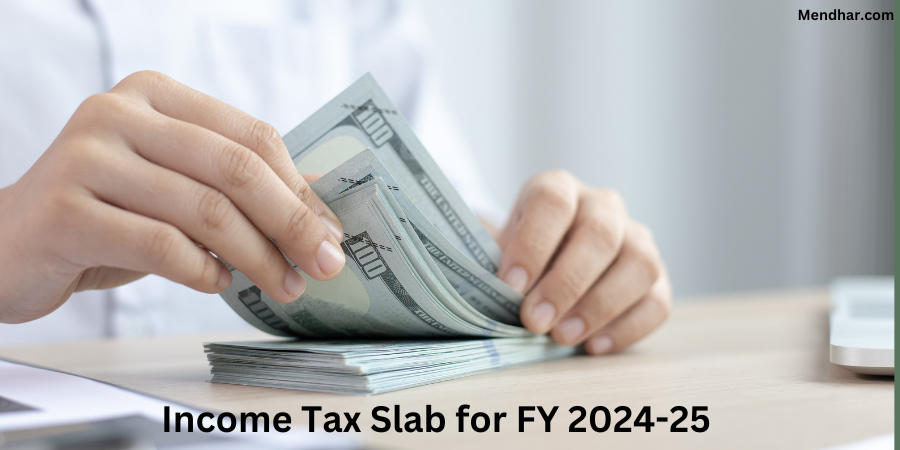Table of Contents
ToggleIncome Tax Slab for FY 2024-25: Slabs, Rates, and Key Updates for AY 2025-26
Effective financial planning starts with understanding income tax structures. For FY 2024-25 (AY 2025-26), the government has introduced updates to benefit taxpayers. This guide provides a detailed overview of the Income Tax Slab for FY 2024-25, key changes announced in Budget 2024, and a comparison of the Old and New Tax Regimes.

Income Tax Slabs for FY 2024-25
India employs a progressive tax system, where tax rates increase with higher income levels. The Income Tax Slab for FY 2024-25 remains consistent with the previous year but incorporates enhanced benefits under Budget 2024.
New Tax Regime (Default System for FY 2024-25)
| Annual Income (₹) | Tax Rate |
|---|---|
| Up to ₹3,00,000 | Nil |
| ₹3,00,001 to ₹7,00,000 | 5% |
| ₹7,00,001 to ₹10,00,000 | 10% |
| ₹10,00,001 to ₹12,00,000 | 15% |
| ₹12,00,001 to ₹15,00,000 | 20% |
| Above ₹15,00,000 | 30% |
Key Benefit: Incomes up to ₹7,00,000 are tax-free due to the rebate under Section 87A.
Old Tax Regime
| Taxpayer Category | Income Range (₹) | Tax Rate |
|---|---|---|
| Individuals (Below 60 years) | Up to ₹2,50,000 | Nil |
| ₹2,50,001 to ₹5,00,000 | 5% | |
| ₹5,00,001 to ₹10,00,000 | 20% | |
| Above ₹10,00,000 | 30% | |
| Senior Citizens (60–80 years) | Up to ₹3,00,000 | Nil |
| ₹3,00,001 to ₹5,00,000 | 5% | |
| ₹5,00,001 to ₹10,00,000 | 20% | |
| Above ₹10,00,000 | 30% | |
| Super Senior Citizens (80+) | Up to ₹5,00,000 | Nil |
| ₹5,00,001 to ₹10,00,000 | 20% | |
| Above ₹10,00,000 | 30% |
Key Changes in Budget 2024
The Income Tax Slab for FY 2024-25 includes updates to enhance tax benefits for taxpayers:
| Change | Details |
|---|---|
| Standard Deduction | Increased from ₹50,000 to ₹75,000 (New Regime). |
| Family Pension Deduction | Raised from ₹15,000 to ₹25,000. |
| NPS Employer Contribution | Increased to 14% of salary (up from 10%). |
| Introduction of NPS-Vatsalya | Enables contributions for minors by parents/guardians. |
Corporate and LLP Tax Rates
| Category | Tax Rate |
|---|---|
| Companies under Section 115BAB | 15% |
| Companies under Section 115BAA | 22% |
| Manufacturing Companies under Section 115BA | 25% |
| Companies with turnover below ₹400 crores | 25% |
| Other Domestic Companies | 30% |
| Partnership Firms and LLPs | 30% |
Surcharge and Cess:
- Surcharge:
- 7% for incomes above ₹1 crore but below ₹10 crore.
- 12% for incomes exceeding ₹10 crore.
- Health and Education Cess: 4% of tax plus surcharge.
Comparing Old and New Tax Regimes
The choice between the Old and New Tax Regimes depends on individual financial planning. The New Regime simplifies taxation but limits deductions, while the Old Regime offers significant exemptions such as:
- Section 80C: Investments in PPF, EPF, and life insurance.
- Section 80D: Health insurance premiums.
- HRA and LTA exemptions.
Example: Taxable Income of ₹8,00,000
| Particulars | Old Regime (₹) | New Regime (₹) |
|---|---|---|
| Income up to ₹2,50,000 | Nil | Nil |
| Income up to ₹3,00,000 | – | Nil |
| ₹2,50,001 to ₹5,00,000 | 12,500 | 10,000 |
| ₹5,00,001 to ₹7,00,000 | 40,000 | 10,000 |
| ₹7,00,001 to ₹8,00,000 | 20,000 | 10,000 |
| Total Tax | 72,500 | 30,000 |
| Cess (4%) | 2,900 | 1,200 |
| Total Tax Payable | ₹75,400 | ₹31,200 |
Key Points for Consideration
- Rebate under Section 87A: Tax-free income up to ₹7,00,000 in the New Regime.
- Reduced Surcharge: Highest surcharge cut from 37% to 25%.
- Higher Standard Deduction: ₹75,000 for salaried individuals under the New Regime.
FAQs: Income Tax Slab for FY 2024-25
1. What is the income tax slab for FY 2024-25 under the New Regime?
The New Regime tax slab rates are as follows:
- Up to ₹3,00,000: Nil
- ₹3,00,001 to ₹7,00,000: 5%
- ₹7,00,001 to ₹10,00,000: 10%
- ₹10,00,001 to ₹12,00,000: 15%
- ₹12,00,001 to ₹15,00,000: 20%
- Above ₹15,00,000: 30%
2. Is the New Tax Regime mandatory for FY 2024-25?
No, the New Regime is the default system, but taxpayers can opt for the Old Regime if it suits their financial planning better.
3. Are there any changes in the Old Tax Regime for FY 2024-25?
No significant changes were made to the Old Regime. However, it continues to offer exemptions and deductions like Section 80C, Section 80D, HRA, and LTA.
4. What are the key updates in Budget 2024 for income taxpayers?
Some key updates include:
- Standard Deduction increased to ₹75,000 under the New Regime.
- Family Pension Deduction raised to ₹25,000.
- NPS employer contribution increased to 14%.
- Introduction of NPS-Vatsalya for minors.
5. Is income up to ₹7,00,000 tax-free under the New Regime?
Yes, income up to ₹7,00,000 is tax-free due to the rebate under Section 87A in the New Regime.
6. How can I decide between the Old and New Tax Regimes?
Evaluate your eligibility for exemptions and deductions under the Old Regime. If you have minimal deductions, the New Regime may result in lower tax liability.
7. Are corporate and LLP tax rates affected in FY 2024-25?
No major changes were made to corporate and LLP tax rates. The rates remain as follows:
- Companies under Section 115BAB: 15%
- Companies under Section 115BAA: 22%
- Partnership firms and LLPs: 30%
8. What is the highest surcharge rate for FY 2024-25?
The highest surcharge rate has been reduced from 37% to 25% for incomes exceeding ₹5 crore.
9. Can salaried individuals claim the standard deduction under both regimes?
Yes, salaried individuals can claim a standard deduction of ₹50,000 under the Old Regime and ₹75,000 under the New Regime for FY 2024-25.
10. Where can I calculate my tax liability for FY 2024-25?
You can use the official income tax calculator available on the Income Tax Department’s website to compare your tax liability under both regimes.
Conclusion
The Income Tax Slab for FY 2024-25 reflects the government’s efforts to simplify the tax system and offer greater flexibility. The New Regime is ideal for those with limited deductions, while the Old Regime is suitable for taxpayers leveraging exemptions. Use official calculators to assess both regimes and choose the one that maximizes your savings.
By adapting to the latest changes in the Income Tax Slab for FY 2024-25, taxpayers can better align their financial strategies with government policies.

